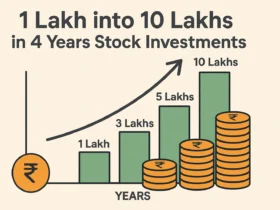When thinking about investing, we often wonder if a one-time payment or a Systematic Investment Plan (SIP) is better. We’ll look into both options, comparing their good and bad sides. SIPs let you start investing with just Rs 500 a month, making it easy for many to begin1. They also help you buy mutual fund units at different times, which can lower the cost over time1.
Starting with Rs 100 a month, SIPs are great for beginners or those with little money2.
Investing in SIPs can start with as little as Rs 500, making it easy for new investors3. SIPs are more flexible than one-time investments, letting you start small and grow your investment over time2. We’ll compare one-time and SIP investments to see which is best for our financial goals and situation. SIPs are good for long-term goals, helping you build wealth over many years2.
Table of Contents
Key Takeaways
- One-time investments and SIPs have their own merits and demerits, and the choice between them depends on individual investor profiles and goals.
- SIPs offer flexibility and a low barrier of entry, with investments starting as low as Rs 500 per month1.
- Lump sum investments require a substantial initial amount, generally starting at Rs 1,000 or more1.
- SIPs enable investors to buy mutual fund units at different market phases, averaging out the cost per unit over time1.
- Investors should consider factors like monthly income, financial stability, investment goals, and risk appetite when selecting between SIP and lumpsum investments3.
- SIPs are suitable for long-term investment goals, aligning with strategies that focus on wealth accumulation over an extended period2.
- Market timing plays a significant role in investment decisions, with lumpsum investments yielding higher returns when the market is low3.
Understanding Investment Fundamentals
Investing wisely starts with knowing the basics. There are two main ways to invest: lump sum and systematic investment plan (SIP). A lump sum is when you invest all your money at once. A SIP lets you invest a set amount regularly4.
Regular investing in a SIP can help smooth out market ups and downs5.
When choosing between lump sum and SIP, understanding the basics is key. SIPs are great for investing small amounts often4. They’re perfect for those who can’t invest a lot at once. On the other hand, if you have a big sum to invest, a lump sum might be better5.
It’s important to think about your risk level and financial goals before deciding5.
SIPs help you invest regularly and can grow your money over time4. You can start a SIP with just ₹500 a month5. This makes it easy for everyone to invest, no matter their income.
By understanding the basics and thinking about your goals, you can choose the best investment for you.
| Investment Option | Key Characteristics |
|---|---|
| Lump Sum Investment | Single complete sum of money, potentially higher returns in good markets |
| Systematic Investment Plan (SIP) | Fixed amount at regular times, smooths out market swings, helps you invest regularly |
The Psychology Behind Investment Choices
Investing is all about investor behavior. Knowing your risk tolerance and financial goals is key. In 2023, the Indian equities market hit a new high, with mid and small-cap stocks leading the way6. Many are turning to Systematic Investment Plans (SIPs) for their simplicity and ability to smooth out market ups and downs6.
Investors often try to time the market, which can lead to hasty choices. But, history shows that compounding is vital for building wealth over time7. By investing for the long haul and increasing SIPs each year, investors can harness compounding’s power. SIPs offer several advantages:
- They encourage regular investing habits
- Automatically buy more units when prices are low
- Help investors follow the ‘Buy low, sell high’ strategy
These benefits help investors overcome the habit of sporadic investing. They encourage a disciplined approach to investing8. By understanding the psychology behind investment choices and using strategies like SIPs, investors can make better decisions and reach their financial goals.
Investor behavior and risk tolerance are key to a successful investment strategy. By focusing on financial goals and risk tolerance, investors can make better choices. This helps them achieve their long-term financial goals6.
Market Timing and Its Impact
Market timing is key for both one-time and SIP investments. Finding the best time to invest a big amount can be hard. It’s important to watch market trends9.
Knowing market cycles helps in making smart investment choices. SIPs help smooth out market ups and downs, thanks to rupee cost averaging10.
Managing risk is vital in investing. Investors can use many strategies to keep their money safe. By understanding market timing, volatility, and risk, you can make better investment choices. SIPs are great for long-term gains, with interest growing over time10.
Risk management is key in investing. Think about your risk level, goals, and time frame to pick the best option. SIPs offer a steady way to invest, use market ups and downs, and make it easy to add money regularly4.
The table below shows why SIPs are good:
| Benefits of SIPs | Description |
|---|---|
| Rupee Cost Averaging | Reduces the impact of market volatility |
| Compounding | Increases returns over time |
| Disciplined Investing | Encourages regular investments |
By understanding market timing, cycles, volatility, and risk, you can make smart investment choices. This leads to better returns and a secure financial future9104.
Which is Better, a One-Time Investment or an SIP?
Investors often face a tough choice between one-time investments and Systematic Investment Plans (SIPs). Each option has its own set of pros and cons. These depend on the investor’s profile, financial goals, and how much risk they can take.
SIPs can start with just ₹500, and some mutual funds even accept ₹10011. This makes SIPs great for those with little money to begin with.
Investing more money generally means better returns11. But SIPs have the advantage of rupee cost averaging. This can lessen the effect of market ups and downs over time12.
Statistical data shows SIPs can lead to higher returns than one-time investments. For example, SIPs have an average monthly return (XIRR) of 14.82% over 7 years13.
Here are some key points to consider when choosing between a one-time investment and an SIP:
- SIPs are perfect for long-term, passive investors. They help reduce the impact of market volatility and add discipline to investing11.
- One-time investments are better for those with extra cash, short-term goals, or specific financial events like selling a property or getting an annual bonus11.
- The choice between SIP and lump sum should be based on cash flow, time horizon, investment profile, and financial targets11.
The decision between a one-time investment and an SIP depends on individual circumstances and market conditions. By weighing the pros and cons and considering their investment profile, investors can make a choice that fits their financial goals and risk tolerance11.
Mathematical Analysis of Returns
We will now explore the math behind investment returns. We’ll look at how compound interest and rupee cost averaging boost long-term growth. Data from14 shows mutual funds can offer big returns over time. Compound interest is key in this process14.
Rupee cost averaging is also vital. It lowers the average cost per unit, which can increase returns15.
Systematic Investment Plans (SIPs) are great because they use compounding to grow returns15. This means returns on your investment earn more returns. SIPs also let you invest in small amounts, making them affordable for many15.
A study from16 found that monthly SIPs can lead to a bigger final amount. This is because of compounding16.
When choosing investment strategies, consider your goals, how long you can invest, and how much risk you can take15. By understanding these and using compound interest and rupee cost averaging, you can make smart choices. This will help you grow your investments over time and get the most out of your returns14.
Case Study: Bull Market Scenario
In a bull market, how and when you invest matters a lot. Investing all at once can lead to better returns than investing a little at a time17. This is true when the market is doing well, allowing you to put more money in early on. For example, the Franklin India Taxshield Fund – Direct Plan saw a 12.21% CAGR and a 41% return over three years17.
Market ups and downs also play a big role. Using a Systematic Investment Plan (SIP) can help smooth out these swings18. It’s also key to know the business cycle and what kind of investments to make17.
Getting help from professionals is also vital. Regular funds offer advice from Certified Financial Planners (CFPs), helping you avoid mistakes19. Regular SIPs mean you get ongoing advice and better performance in a bull market.

Case Study: Bear Market Performance
In a bear market, the value of stocks drops by over 20% after reaching a high20. This can be tough for investors. Yet, it’s a chance for smart investors to buy stocks at lower prices thanks to rupee cost averaging20.
Systematic Investment Plans (SIPs) mean investing a set amount regularly into mutual funds21. Rupee-cost averaging in SIPs means investing the same amount at set times, no matter the market21. This method helps avoid emotional buying and selling by sticking to a long-term plan21.
Some key benefits of SIPs during a bear market include:
- Lowering the overall acquisition cost of stocks due to rupee cost averaging20
- Mitigating emotional decisions during bear markets by committing investors to a long-term investment plan21
- Leveraging the power of compounding, where returns earned on initial investments generate their own returns over time21
Markets usually bounce back after bear markets, showing the value of long-term investment21. By understanding SIPs’ benefits in a bear market, investors can make better choices. This could lead to higher returns over time20.
Tax Implications and Benefits
Understanding the tax side of investments is key to getting the most out of your money22. We’ll look at how taxes affect one-time and SIP investments in mutual funds. Using tax-saving strategies, like ELSS funds, can lower your tax bill23. ELSS is the only mutual fund that lets you save taxes under Section 80C of the Income Tax Act, 196122.
Good financial planning means thinking about taxes when you invest. For example, long-term gains from SIPs don’t get taxed up to Rs. 1 lakh a year23. SIPs also let you change how much you put in or pause your investment if needed24. Here’s a quick table on SIP tax implications:
| Type of Gain | Tax Rate |
|---|---|
| Long-term capital gains | Exempt up to Rs. 1 lakh per financial year23 |
| Short-term gains | 15%23 |
When choosing investments, remember to think about taxes22. Talking to a financial advisor can help find the best tax strategy for you22. Knowing the tax benefits and drawbacks of different investments helps you make choices that fit your financial and tax goals.
Ideal Investment Scenarios
Choosing the right investment strategy is key. It depends on your financial goals and who you are as an investor. A good plan can help you buy a house or save for retirement. Systematic Investment Plans (SIPs) are great for these goals. They let you invest a set amount each month, starting at just ₹50025.
SIPs are perfect for those with steady income. They help you invest the same amount every month. This way, you can handle market ups and downs better26.
If you have extra money, lumpsum investments might be better for long-term goals. But SIPs are best for those who are careful with risk. They’re great for building wealth over time26.
When picking between SIPs and lumpsum, think about your goals, how much risk you can take, and the market. A good strategy fits your financial situation and goals. This way, you can make a plan that works just for you.
Here are some key considerations for choosing between SIPs and lumpsum investments:
- SIPs are suitable for investors with regular income and a long-term perspective25
- Lumpsum investments are suitable for investors with surplus funds and a long-term goal26
- Combining SIPs and lumpsum investments can provide a balanced approach26
The secret to a good investment strategy is knowing your goals and who you are as an investor. By picking the right approach, you can make a plan that helps you reach your financial dreams and grow your wealth over time25.
| Investment Approach | Suitable For | Key Benefits |
|---|---|---|
| SIPs | Investors with regular income and a long-term perspective | Reduces market volatility, provides discipline and stability |
| Lumpsum Investments | Investors with surplus funds and a long-term goal | Provides a chance for higher returns, good for long-term goals |
Common Mistakes to Avoid
Investing wisely means knowing common mistakes that can hurt our returns. Investment mistakes can be very costly. One big error is trying to time the market, which can lead to market timing errors27. This can cause us to miss good opportunities or make bad choices.
Another key point is portfolio diversification. Not diversifying can put too much risk in one place, leading to big losses28. It’s important to check and adjust our portfolios often to keep them in line with our goals.
Some common mistakes to avoid include:
- Postponing investment
- Attempting to time the market
- Investing without specific financial goals
- Pausing SIP contributions
These errors can really hurt our returns and slow down our financial progress27.
Knowing these common mistakes helps us make better investment choices. Regular checks on our investments are key to staying on track and making the right adjustments28.
| Mistake | Impact |
|---|---|
| Postponing investment | Missed opportunities and lower returns |
| Attempting to time the market | Poor investment choices and higher risk |
| Investing without specific financial goals | Unfocused investments and lower returns |
Hybrid Approach: Combining Both Strategies
We think a hybrid investment strategy is great. It mixes the good parts of one-time and Systematic Investment Plans (SIPs). This way, investors can reach their financial goals29. They put some money into big investments and keep adding to SIPs regularly. This method lets them invest wisely and use big money opportunities30.
This strategy is good for those who want to lower risk and get more returns. By spreading their money across different investments, they can handle market ups and downs better. Plus, they can change how much and how often they invest, fitting their budget and goals30.
Some main perks of this strategy are:
- It helps smooth out market ups and downs29
- It’s easier to start with small amounts, helping those with less money30
- It can lead to bigger returns over time, thanks to compounding and long-term investing29
- It helps build a saving habit and can beat inflation30
Choosing a hybrid strategy means investors get the best of both worlds. They can plan their finances better, aiming for their goals while keeping risk low and returns high2930.
Expert Recommendations and Market Insights
Getting advice from professionals is key to smart investing. Understanding market trends is vital. The Nifty50 index hit 25,000 in August, then fell to 24,000 before rising back to 25,00031. This shows why a deep dive into market analysis is necessary before investing.
Experts say to not invest more than 20% of your income to avoid big risks32. Also, keep in mind India’s average inflation rate of about 7%. Make sure your returns beat this32. By thinking about these points and getting expert advice, you can make smart choices and reach your financial targets.
Recently, funds focused on pharma and healthcare did well, with returns around 6.33% in August31. Small cap funds also saw a 2.33% return in the same month31. These numbers show why it’s smart to spread out your investments and get advice to boost your earnings.

| Fund Type | Return in August |
|---|---|
| Pharma and Healthcare Funds | 6.33% |
| Small Cap Funds | 2.33% |
| Multi Cap Funds | 2.19% |
| Large and Mid Cap Funds | 2.02% |
By following expert advice and understanding market trends, you can make wise investment choices. It’s important to get professional guidance and do thorough market analysis. This way, you can increase your earnings and reduce risks.
Conclusion
Looking at the debate between one-time investments and SIPs, we find no one-size-fits-all solution33. The best strategy depends on your financial goals, how much risk you can take, and the market’s state34. One-time investments might do well in good times35. But SIPs help you average costs, stay disciplined, and grow steadily over time34.
Before deciding, think about your goals, how long you can wait, and your comfort with risk35. SIPs have grown to manage over INR 13,38,945 crore as of August 202433. Mutual fund SIPs have seen over INR 23,000 crore in contributions for two months in a row33. Diversifying and sticking to your goals can lead to long-term success, no matter your choice.
FAQ
What is a One-Time Investment?
A one-time investment is when you put a big sum of money into something that could make more money if the market is good.
What is Systematic Investment Planning (SIP)?
Systematic Investment Planning (SIP) means putting a little bit of money into something regularly. Over time, it can grow a lot because of something called compounding.
What are the key differences between One-Time Investments and SIPs?
The main differences are how much money you invest and when. One-time investments are a big sum all at once. SIPs are smaller amounts over time. SIPs also spread out the risk by averaging the cost of investments.
How do psychological factors influence investment decisions?
Your own comfort with risk, what you want to achieve, and how you react to losses or gains can affect your choice. These include not wanting to lose money, feeling too sure of yourself, and trying to pick the best time to invest.
What is the role of market timing in the performance of One-Time Investments and SIPs?
The ups and downs of the market can really change how well your investments do. One-time investments are more at risk because of this. But SIPs can help by spreading out the cost over time.
What are the advantages and disadvantages of One-Time Investments and SIPs?
Whether to choose one-time investments or SIPs depends on your personal situation, goals, how much risk you’re okay with, and how much money you have. There’s no single best choice for everyone, as both have their own benefits.
How do One-Time Investments and SIPs perform during bull and bear markets?
In good times, investing a big sum early can catch the rise in the market. In tough times, SIPs can help by making each investment cost less because of the way they’re spread out.
What are the tax implications of One-Time Investments and SIPs?
Taxes, like short-term and long-term capital gains tax, and special tax-saving funds (ELSS) are important to think about. The length of time you hold onto your investments also matters when deciding between one-time investments and SIPs.
What are the common pitfalls to avoid when choosing between One-Time Investments and SIPs?
Avoid mistakes like trying to guess the market perfectly and not spreading out your investments enough. Also, make sure to rebalance your portfolio regularly.
Can One-Time Investments and SIPs be combined into a hybrid strategy?
Yes, you can mix both by putting some money into big investments and also making regular SIPs. This way, you get the best of both worlds.
What do experts recommend when choosing between One-Time Investments and SIPs?
Experts, like portfolio managers and financial advisors, offer advice based on their experience and studies. They consider current trends, past data, and their own predictions to help you decide.






























2 Comments